WhatIsFrontMissionOnline
Introduction
Whenever someone brings up the words ďFront MissionĒ in a video game conversation, turn-based strategy comes to mind. In fact, thatís how many people view the Front Mission series. So when Front Mission Evolved was announced in June 2009 and was switching to the third-person shooter genre, these same people reacted in outrage and disgust. At least, that appears to be the case with everyone outside of Japan or those who have not followed the series since its conception in 1995. To the fans that have, their response is more likely to be welcoming as they know the series has had installments that were not turn-based strategy games. Three such installments have this distinction: Front Mission: Gun Hazard, Front Mission Alternative, and Front Mission: Online.

Front Mission Alternativeís play is in real-time, not turn-based.
Front Mission: Gun Hazard was a 2D side-scrolling shooter game in the same vein as Masaya's Assault Suits Valken (Cybernator in the English release). In fact, one could say that Gun Hazard is a spiritual successor to it as series visionary, Toshiro Tsuchida, created the aforementioned game. Front Mission Alternative was a strategy game, but it was played in real-time as opposed to turn-based. That leaves the last of the spin-offs, Front Mission: Online. What is Front Mission: Online? Itís a massively multiplayer online (MMO) game in which the player directly controls the actionÖthird-person shooter style. Although online service ended on May 31, 2008, this game made a lasting impact on its players and showed that a radical genre change isnít so bad.
Graphics
Being an MMO, Online isnít exactly a graphical powerhouse, but most MMOs arenít anyways. Being in development alongside Front Mission 4, the game more or less uses the same graphics engine. Itís not the prettiest or vibrant 3D graphics, but it gets the job done. One change from this and Front Mission 4 is that actual 3D character models appear. No, these character models arenít color-coded like in Front Mission 3. They are more detailed than that and add a much-needed connection between the humans and their machines. As the player, you create a character and can customize his/her appearance, a feature thatís standard among MMOs. Series fans can also spot out some recurring characters like Front Mission Firstís Guri B. Olson or Patrick S. Winger, who predictably sport 3D models with better details than the average character.
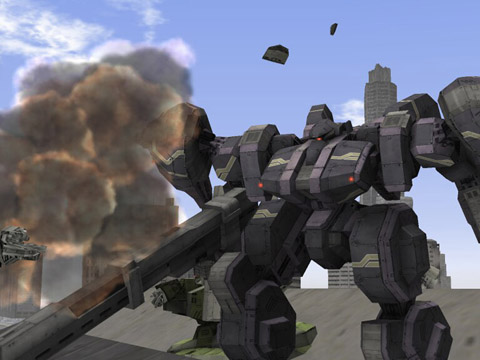
The graphics, excluding the character models, are the same as Front Mission 4ís.
Since Online uses the Front Mission 4 graphics engine, a lot of the wanzer parts and weapons from that game are also in here. However, there are also a ton of new part and weapon models so itís not a complete rehash either. There are some noticeable improvements though; the paint schemes are more diverse and vibrant compared to the dull, bland ones found in Front Mission 4. In addition, the wanzer models have glowing ďeyesĒ akin to Front Mission 5: Scars of the War. While these are minor updates, they do help produce a more colorful, enjoyable playing experience. Where Front Mission: Online shines is in the action on the battlefields and it does not disappoint.
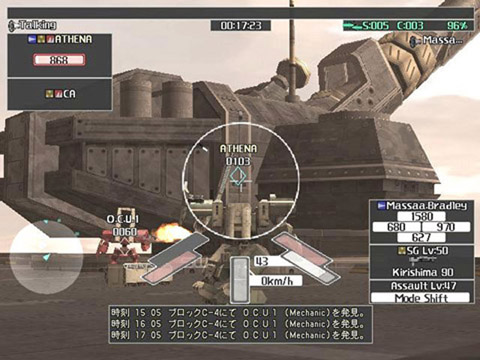
The Morgan Fortress cannons, as seen in Front Mission First, are properly scaled in Online.
When the action starts, players are treated to very detailed battlefields, flashy explosions, and smooth, consistent frame rates. Think of Front Mission 4, remove the dull parts, and spice up everything it had to offer and thatís what Online is. The scale and scope of the battlefields are beautifully realized, from Fort Monusí maze of roads to the massive cannons at the Morgan Fortress. Sometimes it pays to stop fighting and appreciate the detail that went into creating these environments. The game also runs at a smooth 60 frames per second and stays rock solid, even during hectic combat moments. Online lag is always an issue with MMOs, but thankfully, Front Mission: Online does a good job of keeping them to a minimum.
Music & Sound Effects
Front Missionís history in music and visual arts is very diverse and itís difficult to identify who truly represents the series. However, if one person had to be singled out, it would be Hidenori Iwasaki. The composer of Front Mission 4 and 5: Scars of the War (along with new renditions of music in Front Mission First), Iwasaki has also worked on Online. While Iwasaki has created new tracks for this game, a lot of them are remakes of tracks from previous games. Tracks from Front Mission Alternative, First, 2, 3, and 4 (yes, even 4) can be heard, from the catchy Evils of War in 1st to the foreboding Tension in 2. Some are better than the original compositions, like the ones from Front Mission 2, but the most of the new revisions sound weaker. It gets the job done, but the soundtrack leaves a lot to be desired.
The sound effects are mostly recycled from Front Mission 4, but have been amped up to be more lively and involving. Shotgun rounds sound more booming, melee strikes feel more painful, and the machines exploding are pretty convincing. What are new to Front Mission: Online are English voice-overs, which makes the action experience quite immersive. The voice-overs are a great addition and hearing words like ďMechanic, I need repairs!Ē in battle makes victory all the sweeter. Think of the radio chatter from Namco Bandaiís Ace Combat series and itís the same idea here in Online.
Story & Plot
The MMO genre, because of its emphasis on social interaction, isnít necessarily heavy on storytelling. Most offerings in the genre are heavy on game history and lore, but outside of this, the story is whatever the player wants it to be. Front Mission: Online isnít an exception to this standard, but impressively, it does offer a traditional storytelling approach similar to Final Fantasy XI. The game takes place during the 2nd Huffman Conflict (series fans should know what this isÖsee Front Mission First), from the outbreak to its conclusion. While there is no deviation from how the war progresses, Online covers a lot of the action in-between the major events.
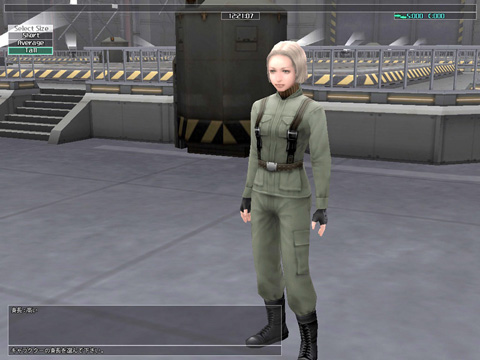
Creating a pilot offers numerous options, such as changing their height.
The player starts off choosing one of the two warring powers, the Oceania Cooperative Union (O.C.U.) or the United States of the New Continent (U.S.N.). After choosing a side, players can take part in the various operations taking place on Huffman Island. Once at a certain rank, a player can choose to defect to the opposing side and fight the war on their behalf. Each side has its set of unique characters, some who are recurring, which progress the story; players can see Guri Olson issuing operations to the infamous Canyon Crows on the O.C.U. side, or watch Patrick Winger plan a take-over of a local town in the U.S.N. side.
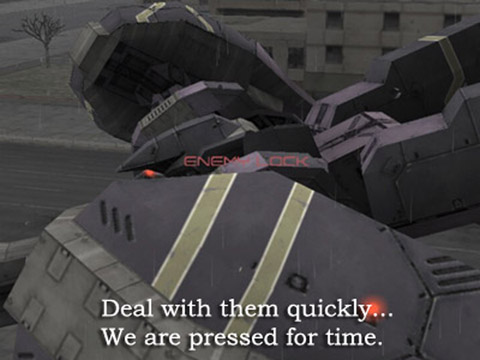
One of the unique O.C.U. story campaigns against the Type 11 Raven.
These plot elements were reinforced by special, one-time only campaigns, released at specific timeframes during the gameís run from 2005 to 2008. These campaigns were also timed in accordance to how the 2nd Huffman Conflict unfolds, such as Operation Eagle Tears in the final days of the online service. Needless to say, they helped create a sense of plot progression for the players and made for an immersive experience. However, due to its focus on showing the lesser-known parts of the conflict, Online could be considered a legitimate story entry in the main series. As the game was never localized for overseas release, many people will never get a chance to experience the full story behind the 2nd Huffman Conflict.
Game Mechanics
As mentioned earlier, Front Mission: Online is a third-person shooter style game. It still has many traditional Front Mission elements, such as the customization of the wanzers, but the action is played out in real-time. The third-person shooter elements are comparable to From Softwareís Armored Core, but it actually doesnít quite play the same. Once registered in the game, players create their pilots and choose a specific job to train under. These jobs come with special ability perks (Missileer pilots have quicker missile lock-ons) that determines what kinds of wanzer setups will work best.
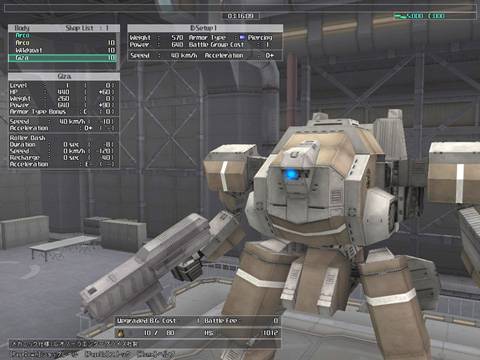
The customization options and interface are similar to ones found in other Front Missions.
From here, players can form squads with other players and take on operations to improve their proficiencies and military rankings. Prior to embarking on operations, players are free to customize their wanzers in any way they see fit. The customization in Online is similar to other Front Mission games with no real new additions or major tweaks. A player can change their part and weapon loadouts, apply different paint schemes, and so on. When finished, a number of operations can be selected on the Huffman Island map. Like in most MMOs, their availability depends on how far the players have progressed their characterís rank and standing.
During an operation, the playerís goal is to achieve whatever objective will result in a victory. These operations can be Player-versus-Enemy (PvE), Player-versus-Enemy (PvP), or a combination of both. The third-person elements come into play when an operation starts. A wanzer can be controlled to do simple actions such as crouch, walk, run, and roller dash (think boosting from Armored Core). Players can do other, more combat-related actions such as using equipped weapons, cycling through equipped weapons, or zooming in the targeting system to first-person mode. Itís quite similar to how Armored Core functions in this respect.
Where Front Mission: Online differs from Armored Core is entirely in how it approaches the combat. True to the series, the wanzers arenít be-all, end-all war machines that can dominate every other kind of military weapon. No, wanzers are still versatile, but easily destroyable units that must work in groups to succeed. Teamwork and cohesion are far more important than individual skill and combat setup in Online. Solo play is possible, but given the design of the gameís campaigns and the vulnerability of wanzers, itís nearly impossible to complete operations alone and virtually all players work in teams.
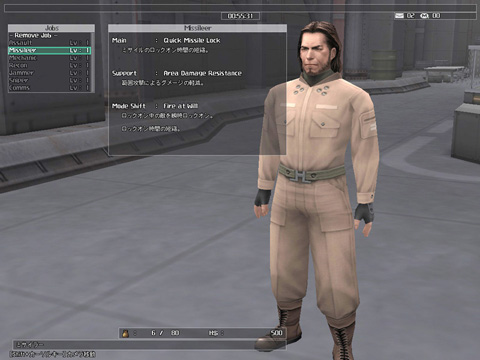
The Missileer job improves a pilotís ability to use indirect fire weapons such as missile launchers.
This squad-based focus keeps the combat, fresh, intense, and surprisingly strategic. Does the team need Missileers to take advantage of the Reconís weapon guidance abilities? Or are Snipers needed to take out units disabled by Jammers? What about a Comms pilot to help bring ammo supplies to the Assaults on the frontlines? A lot of these options allow Online to stay true to Front Missionís strategy-based roots and helps players feel like they are soldiers fighting for their armies. This is especially true during the special campaigns, where as many as 50 player units can be fighting at once on a battlefield. These qualities also give players a true sense of accomplishment when their squad captures a military base or manages to destroy a massive mobile weapon.
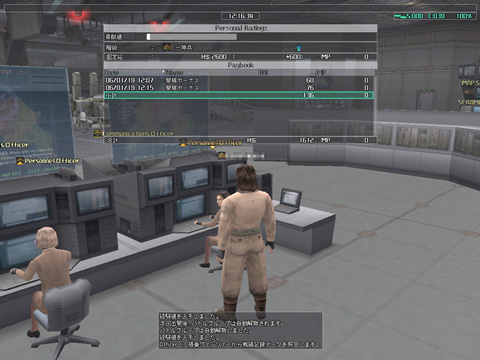
A pilotís military rank determines the kind of operations they can choose and what parts and weapons they can purchase.
Operations aside, the player can also take part in the Arena, a common Front Mission feature, to earn cash for customizing their wanzers. The money earned can also be used to purchase various clothing and other accessories for the pilots to wear, including berets and sunglasses. There isnít much to do outside of the operations, but given the military-heavy nature of the game, itís appropriate.
Conclusion
Despite being online for only three years, Front Mission: Online proved that the series can translate well into the third-person shooter genre. Not only did it provide fast-paced action, but it also allowed for plenty of strategy due to its team-oriented focus. The unique story campaigns helped give players a reason to keep playing and feel invested in the game. Itís only true flaw is that Square Enix never considered it for release outside of Japan, even though they held pre-beta sessions in North America.
The upcoming Front Mission Evolved is confirmed to have online play, but to what extent remains to be seen. It may not be up to the same level of scope that Front Mission: Online has, but hopefully it will provide a similar and enjoyable experience. As the world looks onto its eventual release, donít look at Evolved with a closed mind. After all, Front Mission is no stranger to change and if Online proved third-person shooters can work, why not Evolved?
